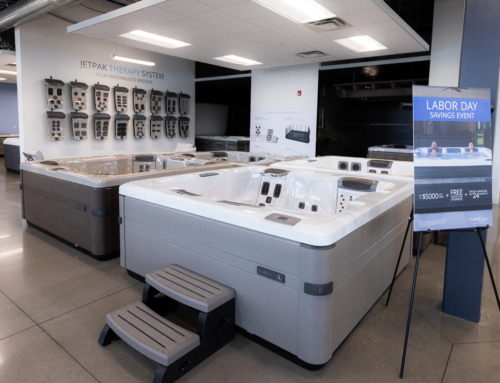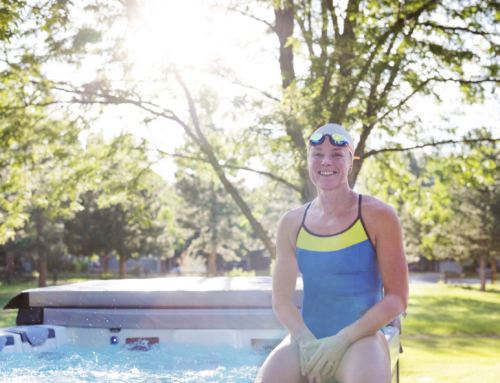As you plan, evaluate, and look for ways to improve the bottom line of your retail business, selecting products is no doubt at the top of your key decisions list. Should you sell other categories in addition to hot tubs? And just how does a retailer approach this decision process?
When choosing product offerings, basic considerations include marketability, profit margin, sales volume potential, product fit, and recurring sales probability. Whether “purchasing agent” is one of the many hats that you wear as a manager or you are the buyer for a chain of pool and spa stores, it’s up to you to choose products that maximize profit potential when properly marketed and sold.
Sales per Square Foot
One popular method of tracking and evaluating product performance in retail is to calculate and consider sales per square foot for a specified period of time. By doing this, you’ll be able to evaluate the performance of different departments, product categories, or even specific products, which in turn informs the best use of your valuable retail space.
There is no magic sales dollar amount per square foot standard for the spa industry.
Unfortunately, there is no magic sales dollar amount per square foot standard for the spa industry. The volume of sales per square foot required for a spa store to be successful will vary based on the per square foot rent of the store, varying profit margins that different products yield, store operating expenses, etc. The point of taking the time to calculate sales per square foot is not that there is an industry standard that should be met. Rather, you are trying to maximize your sales per square foot and by knowing that number, you will be able to track the effects of the product offering decisions you make.
In order to calculate and evaluate your sales per square foot, follow these seven steps:
- Calculate total area of existing retail space.
- Calculate total retail sales for a period of time for the existing space across all departments or categories (e.g., spas, chemicals, accessories, parts, etc.) by adding all sales together.
- Calculate total average sales per square foot by dividing the total retail sales by the total area.
- Calculate average retail sales per square foot for each department or product category. Do this by following steps 1-3 for each of your retail departments.
- Compare department sales per square foot averages with total average sales per square foot.
- Make the above calculations using sales figures from each of the previous four quarters. Going forward, make the same calculations at the end of each quarter. Track your results, along with notes regarding product offering and space changes.
- Use the information gathered to help make decisions regarding new products to offer, existing products to discontinue, and retail space allocations. Consider increasing department square footage for departments with higher averages than the total average. Decrease department square footage for departments with a lower average than the total average.
Marketability
Predicting sales volume is perhaps the most difficult and, at the same time, the most important aspect of determining the mix of products you’ll offer. As long as product margin is adequate, profits are derived from the demand that exists–or you create–for the products you sell. It’s your job to gauge that demand and select products with sufficiently strong demand.
When working to select easily marketed products, timing can be extremely important. New trends and products can be a great boost to your business, but you’ll need to be at the beginning of the product lifecycle in order to be successful. Learning to pick a hot product even before it becomes popular is a valuable skill that comes from knowing your market.
Profit Margin
When considering products to offer be sure to take the time to understand the costs associated with selling the products and the profit margins that can be expected. Selling big ticket items is generally more profitable, but if you can create strong volume, even smaller price tags can yield big profits.
Recurring Revenue
As much as possible, choose products with recurring sales value. It is always wise to offer a variety of products that are consumable or need to be replaced on a regular basis. More importantly when selecting your core product lines and deciding how to allocate floor space (i.e., where to dedicate time and energy), consider the recurring sales potential created by those products.
The sale of a spa creates the potential for many future sales to your new customers. Some examples include:
- Replacement spa covers
- Cover lifts
- Steps and railings
- Spa and outdoor stereo systems
- Replacement filters
- Chemicals and water care products
- Spa accessories
- Gazebos and enclosures
- Furniture
Competition
Knowing who your competitors are, the products they sell, the prices they charge, and the value that they add is critical to designing your product offerings. Search out and seize opportunities to be unique in your product mix. Add products that allow you to add value and differentiate yourself from the competition.
The products large retailers infuse into the market can help substantiate the value of your product offerings as well as create opportunities for the sale of related products.
Don’t fear big box retailers. Possible methods to differentiate your store from large retail chains are endless. In fact, the products these large retailers infuse into the market can help substantiate the value of your product offerings as well as create opportunities for the sale of related products. Watch for the chance to offer products that add value to or even fix popular big box goods.
Here are some examples of ways that a smaller backyard retail store might leverage sales made by larger retailers.
- Offer a reasonably priced pump and filter set that replaces the inadequate circulation systems included with many above ground pool kits.
- Stock replacement filter cartridges, covers, or even parts for the brands of pools and spas found at the local big box store.
- Earn the recurring revenue stream that accompanies a large retailer’s spa sale by creating a new spa owner care product kit and teaching the customer how to use it.
- Help customers to improve the cooking results from their standard charcoal grill by teaching them to use your specialty charcoal, rubs, cooking tools, etc.
Product Fit
Be sure to choose products that fit your business type, who you are as a company, and how you want to be perceived in the market. Consider your mission statement, core company values, and marketing messages when selecting products. Even an item with strong demand and good margins but doesn’t fit what you are as a company can do more harm than good.
Even an item with strong demand and good margins but doesn’t fit what you are as a company can do more harm than good.
Product quality is important to assess, especially when you’re working to maintain a reputation as a source for high-end products/service and to build a continuous stream of revenue from each customer. One of the best ways to do this is to build customer trust by maintaining a consistent level of quality across all products.
A key to having a successful business is to know your products and to believe in the merchandise you’re selling. If you don’t believe in the product yourself, then you probably won’t be successful at selling it. Take the time to plan and you’ll find products that complement your offerings and meet the needs of your target market.









Leave A Comment